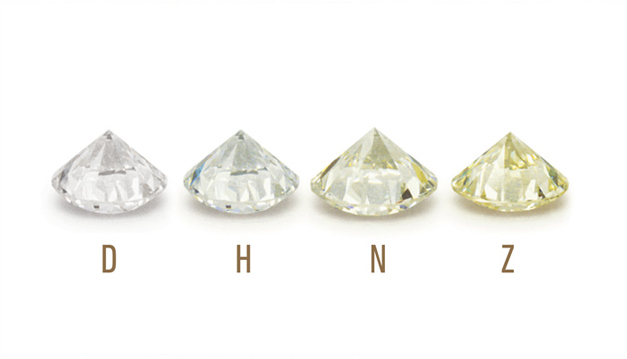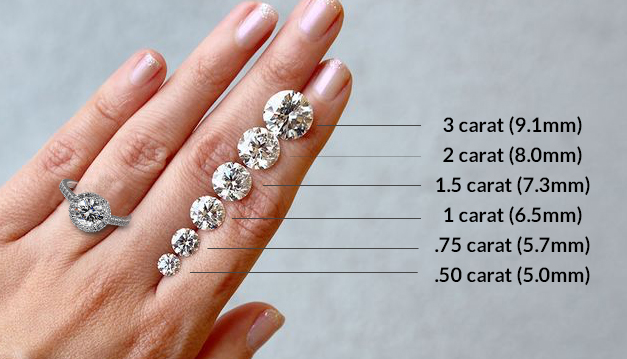Get insight into what the 4Cs really mean — and know where you can give a little and still get a beautiful diamond.
We at Jewel Bear absolutely believe you can spend less for a better diamond. Set a budget that works for you. Do your homework. And keep the following important diamond buying tips in mind.
In the same way that you check the service history of a car or the rating of a high-end restaurant before you book a reservation, you can compare the quality and value of diamonds based on their grade.
That grade is made up of four factors, often known as the 4Cs: cut, clarity, color and carat weight. Each “C” has its own grading scale for evaluating quality. Put together, the diamond 4Cs help diamond sellers determine price and compare diamonds to one another.
Why the 4Cs matter
When the diamond 4Cs were introduced in the mid-20th century, for the first time ever the world had a universal standard for judging the quality of a diamond and a transparent way of determining its value. The 4Cs also became a tool for people to understand why they might want to buy one diamond over another, when it was often hard to discern differences between two different diamonds with the naked eye.
The diamond 4Cs are still as important today as they’ve always been. However, a renewed emphasis on one of the Cs (cut) can help a diamond shine more brilliantly. Knowing this means you as a shopper can prioritize some Cs over others to find a diamond that works within your budget.

Color
Diamond color actually means lack of color. The diamond color evaluation of most gem-quality diamonds is based on the absence of color. A chemically pure and structurally perfect diamond has no hue, like a drop of pure water, and consequently, a higher value. GIA’s D-to-Z diamond color-grading system measures the degree of colorlessness by comparing a stone under controlled lighting and precise viewing conditions to master’s tones of established color value.

CARAT
Each carat can be subdivided into 100 ‘points.’ This allows very precise measurements to the hundredth decimal place. A jeweler may describe the weight of a diamond below one carat by its ‘points’ alone. For instance, the jeweler may refer to a diamond that weighs 0.25 carats as a ‘twenty-five pointer.’ Diamond weights greater than one carat are expressed in carats and decimals. A 1.08 carat stone would be described as ‘one point oh eight carats.’
All else being equal, diamond price increases with diamond carat weight because larger diamonds are rarer and more desirable. But two diamonds of equal carat weight can have very different values (and prices) depending on three other factors of the diamond 4Cs: Clarity, Color, and Cut.
It’s important to remember that a diamond’s value is determined using all of the 4Cs, not just carat weight.
Scale for standard round brilliant diamonds in the D-to-Z diamond color range contains 5 grades ranging from Excellent to Poor.

CLARITY
Diamond Clarity Refers to the Absence of Inclusions and Blemishes. Many of these diamond color distinctions are so subtle that they are invisible to the untrained eye; however, these distinctions make a very big difference in diamond quality and price.
Natural diamonds are the result of carbon exposed to tremendous heat and pressure deep in the earth. This process can result in a variety of internal characteristics called ‘inclusions’ and external characteristics called ‘blemishes.’ Evaluating diamond clarity involves determining the number, size, relief, nature, and position of these characteristics, as well as how these affect the overall appearance of the stone. While no diamond is perfectly pure, the closer it comes, the higher its value.
The GIA Diamond Clarity Scale has 6 categories, some of which are divided, for a total of 11 specific grades.
Many inclusions and blemishes are too tiny to be seen by anyone other than a trained diamond grader. To the naked eye, a VS1 and an SI2 diamond may look the same, but these diamonds are quite different in terms of overall quality. Therefore expert and accurate assessment of diamond clarity is extremely important.

CUT
Diamond Carat Weight Measures a Diamond’s Apparent Size. Diamond carat weight is the measurement of how much a diamond weigh. A metric “carat” is defined as 200 milligrams.
A Diamond’s Cut Unleashes Its Light. Diamonds are renowned for their ability to transmit light and sparkle so intensely. We often think of a diamond’s cut as shape (round, heart, oval, marquise, pear), but a diamond’s cut grade is about how well a diamond’s facets interact with light. Precise artistry and workmanship are required to fashion a stone, so its proportions, symmetry and polish deliver the magnificent return of light only possible in a diamond. A diamond’s cut is crucial to the stone’s final beauty and value. And of all the diamond 4Cs, it is the most complex and technically difficult to analyze.
To determine the cut grade of the standard round brilliant diamond – the shape that dominates most of the diamond jewelry – GIA calculates the proportions of those facets that influence the diamond’s face-up appearance. These proportions allow GIA to evaluate how successfully a diamond interacts with light to create desirable visual effects such as:
GIA’s diamond cut grade also considers the design and craftsmanship of the diamond, including its weight relative to its diameter, its girdle thickness (which affects its durability), the symmetry of its facet arrangement, and the quality of polish on those facets.